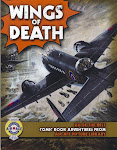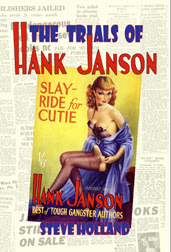 Ricardo Garijo, an Argentinean cartoonist, illustrator, teacher and writer who worked extensively for D. C. Thomson for almost twenty-five years, died on 3 October, aged 55.
Ricardo Garijo, an Argentinean cartoonist, illustrator, teacher and writer who worked extensively for D. C. Thomson for almost twenty-five years, died on 3 October, aged 55.Born in Tandil in Argentina's Buenos Aires Province in 1953, he was the second son of Spanish immigrant parents, his father a survivor of a German concentration camp, whilst his mother was active in the French Resistance. As a baby, Garijo was swaddled in clothing made from British parachutes. He learned to speak English by watching American movies and listening to the Beatles.
As a boy he had two main passions, the American space program and the Second World War. He collected photographs, books and magazine articles about early space flight. He produced numerous portraits of astronauts and, in 1986, was invited by NASA to exhibit some of his work in Argentina. He received a personal letter from Alan Bean, the fourth man to walk on the Moon, who had devoted himself to painting ever since leaving NASA.
At the age of 23 he travelled through Europe, hitchhiking from Spain to Sweden. Returning to Argentina, he began working as an artist, initially scripting and drawing science fiction strips for daily newspapers: "Planeta de Acero" [Steel Planet] for La Capital, published in Mar del Plata (1979-80) and "Lomax—Un Viaje al Espacio Profundo" for La Razon, published in Buenos Aires (1981-82). The latter involved astronauts sent on a journey into deep space in his shuttle by a nuclear explosion and ended abruptly when the paper dropped all its comic strips.
 In Argentina, he produced illustrations for books and contributed to Skorpio before beginning his two and a half decade association with Scottish publisher D. C. Thomson via his agent Cesar Spadari. His earliest known strip was the Alan Hemus-penned "Blue Hawk One" in Champ in 1985, about a futuristic intelligent helicopter and its pilot. Hemus was also a leading writer for Starblazer and the two were re-teamed for a series of comedy buddy-cop stories featuring the mismatched Grok and Zero, which ran for six episodes (1986-90). Discovering that Garijo had a talent for comedy, he was also assigned to draw The Robot Kid series (1987-90) written by Mike Chinn, in which a robotic cinema usher, programmed with every movie cliche possible, is sent to protect a frontier planet from attack. Over the course of three stories, the series parodied the Sergio Leone Western, Martial Arts movies and Rambo-esque actioners.
In Argentina, he produced illustrations for books and contributed to Skorpio before beginning his two and a half decade association with Scottish publisher D. C. Thomson via his agent Cesar Spadari. His earliest known strip was the Alan Hemus-penned "Blue Hawk One" in Champ in 1985, about a futuristic intelligent helicopter and its pilot. Hemus was also a leading writer for Starblazer and the two were re-teamed for a series of comedy buddy-cop stories featuring the mismatched Grok and Zero, which ran for six episodes (1986-90). Discovering that Garijo had a talent for comedy, he was also assigned to draw The Robot Kid series (1987-90) written by Mike Chinn, in which a robotic cinema usher, programmed with every movie cliche possible, is sent to protect a frontier planet from attack. Over the course of three stories, the series parodied the Sergio Leone Western, Martial Arts movies and Rambo-esque actioners.When Starblazer came to an end, Garijo switched to war stories for Commando, beginning with "Another Tight Spot" (#2469, May 1991) and averaging an issue every two months. In all he produced about 90 issues, the latest, "Need to Know" (#4236), on the shelves at the time of his death.
Garijo was also a popular artist in Italy, where he drew for Lancio, and Spain, where he produced two volumes of erotic adventures, Carol entre Rejas [Carol in Jail] (1991) and Carol en Buenos Aires (1991) for Ediciones La Cúpula.
Back in his homeland, he worked with screenwriter Raúl O. Echegaray to produce a series of publications for the Center of Educational Production of Universidad Nacional de Centro de la Provincia de Buenos Aires (UNCPBA), which resulted in the publication of Taller integral de historietas in 2001, a textbook for teaching art. Backed by the university, he launched Gurbos in Extinción in 1997, dedicated to the best of South American comic art, and published a number of collections, including Historietas en la Biblioteca 1 (2001) and Historietas en la Biblioteca 2 (2002) featuring art by students at workshops held by Garijo and Echegaray. One of Garijo's final collaborations with Echegaray before Gurbos folded was Diario de Plaza Moreno (2002), collecting together nine stories set in Tandil, where both authors lived.
In 2003 he produced 49 pieces of artwork for the Don't Let It Happen Here trading cards, followed by The Art of H. G. Wells in 2006, 102 cards across three series depicting scenes from The Time Machine, The Island of Dr Moreau and The War of the Worlds. Both sets were published by Monsterwax.
 He published his first novel, El fuego [The Fire] in 2004, which won the Primer Premio en el Concurso de Narrativa Autores Tandileses and earned him the Faja de Honor of the Instituto Cultural de la Provincia de Buenos Aires. It was reprinted in 2007. A year later, his short story "Los Trenes" [The Station] won first prize in a competition organised by the Fondo Nacional de las Artes. A second novel, El cielo de piedra [The Sky Stone], about his father's internment at a concentration camp in Mauthausen, Austria, is to be published shortly.
He published his first novel, El fuego [The Fire] in 2004, which won the Primer Premio en el Concurso de Narrativa Autores Tandileses and earned him the Faja de Honor of the Instituto Cultural de la Provincia de Buenos Aires. It was reprinted in 2007. A year later, his short story "Los Trenes" [The Station] won first prize in a competition organised by the Fondo Nacional de las Artes. A second novel, El cielo de piedra [The Sky Stone], about his father's internment at a concentration camp in Mauthausen, Austria, is to be published shortly.In 2007 Garijo was invited to participate with other prestigious Argentine artists in the 50/30 project (50 years of El Eternauta / 30 years without Oesterheld) sponsored by Argentina's Ministry of Education, Science and Technology.
Garijo was married to Adriana, a teacher, in 1980 and is survived by her and their three children.
Tributes have been paid by some of the D. C. Thomson editorial staff who worked with Garijo on the Commando website.
 Interviews: Prensa Espacial, 26 February 2008 (in Spanish, about his astronaut portraits)
Interviews: Prensa Espacial, 26 February 2008 (in Spanish, about his astronaut portraits)(* photograph from El Eco de Tandil, 4 October 2009; artwork (c) Ricardo Garijo.)























































This is a terrific video. It's a delight to see Ricardo in his studio doing what he loved. Being in the USA, I never met Ricardo in person, but he became my favorite artist. He was not only a great painter and clever writer, he had a wonderful sense of humor and was impossible not to like and admire. He is sorely missed.
ReplyDelete